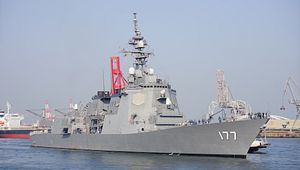The Japan Maritime Self Defense Force (JMSDF) will purportedly dispatch an unknown number of destroyers to the East China Sea to conduct joint naval drills with the U.S. Navy’s nuclear-powered Nimitz-class aircraft carrier USS Carl Vinson and its battlegroup, unnamed sources told Reuters on April 11.
“The Japanese Maritime Self Defense Force (MSDF) may conduct helicopter landings on each other’s ships, as well as communication drills, as the USS Carl Vinson and its escort ships pass through waters close to Japanese territory,” Reuters reports citing two well-placed sources.
“Japan wants to dispatch several destroyers as the Carl Vinson enters the East China Sea,” said one of the sources. A number of JMSDF destroyers are equipped with the so-called Aegis Combat System Baseline 9, specifically designed for ballistic missile defense.
The USS Carl Vinson along with two Arleigh Burke-class guided-missile destroyers and one Ticonderoga-class guided-missile cruiser is currently steaming towards the Korean Peninsula amid rising tensions with North Korea following the communist regime’s latest medium-range ballistic missile test.
The USS Carl Vinson only recently departed South Korean waters.
“Last month, the carrier strike group participated in the Republic of Korea-United States Combined Forces Command eight week-long Foal Eagle exercise, a series of military drills conducted by U.S. and South Korean air, ground, naval, and special operations forces,” I reported on Monday. “Together with the Key Resolve computer-simulated command post exercise, Foal Eagle is the largest annually-held joint U.S.-South Korean military drill.”
In response to Pyongyang’s recent actions, Seoul successfully test fired a new ballistic missile with an estimated range of 800 kilometers in early April. The missile likely was an improved variant of the Hyunmoo (현무, which literally means “Guardian of the Northern Sky”) ballistic missile. It is scheduled to become operational by the end of 2017.
The U.S. government has openly been considering preemptive strikes against the North Korean regime. “North Korea is looking for trouble,” U.S. President Donald Trump wrote on Twitter on April 11, adding that if “China decides to help, that would be great. If not, we will solve the problem without them!” The Trump administration, however, vowed to only commence military actions following close consultations with its regional allies.
Pyongyang in turn threatened with nuclear retaliation, according to Reuters quoting North Korean media. “Our revolutionary strong army is keenly watching every move by enemy elements,” an article in the state-owned Rodong Sinmun newspaper said. “With our nuclear sight focused on the U.S. invasionary bases, not only in South Korea and the Pacific operation theatre but also in the U.S. mainland.”
China, meanwhile, has threatened to impose an oil embargo on North Korea should it continue to defy UN Security Council (UNSC) resolutions. “More and more Chinese support the view that the government should enhance sanctions over Pyongyang’s nuclear activities,” an editorial in the state-owned Global Times stated on April 12. “If the North makes another provocative move this month, the Chinese society will be willing to see the UNSC adopt severe restrictive measures that have never been seen before, such as restricting oil imports to the North.”
































